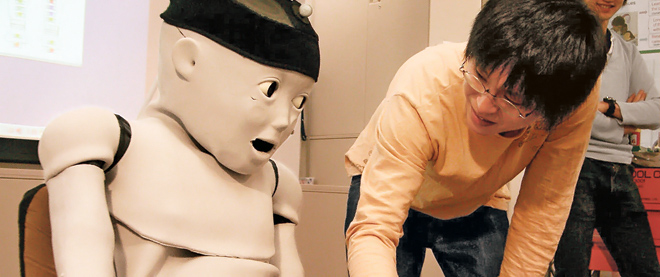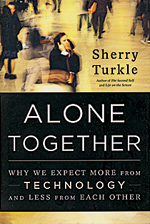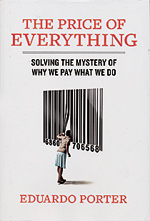Why we’re all feeling more alone
Plus, the reason we tip cab drivers we’ll never see again, a historical romance,
a masterful history, pioneer scientists and a rape survivor’s search for justice
Share

 ALONE TOGETHER: WHY WE EXPECT MORE FROM TECHNOLOGY AND LESS FROM EACH OTHER
ALONE TOGETHER: WHY WE EXPECT MORE FROM TECHNOLOGY AND LESS FROM EACH OTHER
Sherry Turkle
A clinical psychologist and director of MIT’s Initiative on Technology and Self, Turkle has spent two decades studying how material technology is transforming our immaterial selves. In the 1980s, she notes, that was a matter of a strange new, one-on-one relationship, human and computer; by the middle of the next decade Turkle was examining the way computers had become a means of allowing people to live parallel lives in virtual worlds with vast networks of others, something many of them found far more satisfying than real life.
Now, 15 years later, Turkle finds herself examining how two digital culture trends intertwine: mobility, where smartphones allow us to go virtual when we please; and the new robots, not the un-alive-looking ones in factories, but the snuggly types bringing a new kind of companionship into homes for the aged. Both trends often leave us less connected to other humans and more connected to simulations of them. An acute observer, Turkle is particularly concerned by the effect on parenting, as she surveys playgrounds full of adults with one hand on their kid’s swing and the other holding a BlackBerry. Turkle is not all doom and gloom. She acknowledges the convenience and connectivity that texting and email bring, and also that technology itself didn’t make us want to run away from our lives—like alcohol, drugs and affairs, it merely provides the means to do so. Nor has it (yet) done us permanent damage. Among the hundreds of her interview subjects, Turkle turned up teens who fear the actual human contact of making phone calls, mothers who worry that texting with their daughters makes communication more frequent but also more shallow, Facebook members who both utilize and deride status updates. All of them, she argues, reveal their humanity in their feeling that something is wrong about the way that what was meant to facilitate communication actually pushes people apart.
Brian Bethune
 THE PRICE OF EVERYTHING: SOLVING THE MYSTERY OF WHY WE PAY WHAT WE DO
THE PRICE OF EVERYTHING: SOLVING THE MYSTERY OF WHY WE PAY WHAT WE DO
Eduardo Porter
As the title suggests, the central thesis of The Price of Everything is that everything in life—including life itself—has a price (just ask an insurance company). This is familiar ground for economists, who have long believed in the market’s power to assign a monetary value to everything from real estate to razor blades, based on the laws of supply and demand. In turn, the existence of market prices offers a way to predict people’s behaviour, since it’s generally believed that people respond to fluctuating prices in a way that maximizes their well-being.
But where Eduardo Porter, a member of the New York Times editorial board, strays from more conventional thinking is by using prices to explain non-commercial decisions. Like choosing to believe in a religion (followers determine that the rewards of believing, including eternal salvation, outweigh the price of living under stricter rules). He also argues that people don’t always behave rationally, at least financially speaking. Take, for example, the practice of tipping. Why give extra money to a taxi driver whom you are likely never to see again? We do it because we believe there’s a perceived social price to be paid for not leaving a few extra bucks. Similarly, one study showed people are less likely to give blood if they are paid to do so, as if receiving money somehow crowds out the benefits derived from donation.
Porter says these sorts of outcomes throw a serious wrench into conventional economic theories, and that it’s time we stopped trying to explain them away as examples of “irrational” behaviour. After all, existing theories did a poor job of predicting earth-shaking economic events such as the 2008 financial collapse, which resulted from Americans piling into an inflated housing market. Perhaps a better understanding of prices and what’s behind them would help us avoid a similar fate in the future. Chris Sorensen

BRIDE OF NEW FRANCE
Suzanne Desrochers
Few characters in Canadian lore are as romanticized as les filles du roi—the approximately 800 young Frenchwomen who were sent in the late 17th century to marry the settlers in Quebec, frequently described as “brave” and responsible for “creating a nation.” Images depict them with blushed cheeks and flattering frocks; some accounts suggest they were hand-picked for their health, education and upbringing. In reality, many of the filles were impoverished—peasants, orphans, infirm. About a third of them were recruited from the Salpêtrière, a Paris hospital that served as a prison for the city’s poor.
In her novel, Desrochers imagines the life of 17-year-old Laure Beausejour, who is sent to Canada as punishment for writing a letter to the king about the miserable conditions at the Salpêtrière. Laure is terrified of the frozen land to which she has been banished and has no interest in the men who await her there, many of whom were equally disenfranchised back home. But she believes that she might live more freely in New France, and determines to survive. The sea voyage, which often lasted months, left the girls stinking and starving. They did have some say in who they wed (and could even annul a marriage if a man misrepresented his wealth), but often found themselves isolated in the forest, mistresses of mere shacks and at the mercy of men they barely knew. Laure, for one, is left alone through her first Canadian winter, trapped in a shack with little to eat, while her coureur de bois husband goes off in pursuit of fur (and women).
Desrochers’ graceful writing softens the desolation of her heroine only slightly; the story’s real reprieve is in the love affair between Laure and an Ir
oquois man, as illicit as it is unlikely. And, of course, doomed. Romance, it seems, is hard to resist as a way of dressing up the real experiences of the king’s daughters, even in this story that comes close to truly capturing them.
Dafna Izenberg
 BLOODLANDS: EUROPE BETWEEN HITLER AND STALIN
BLOODLANDS: EUROPE BETWEEN HITLER AND STALIN
Timothy Snyder
“We await you, red plague / to deliver us from the black death.” The poet was a soldier in Poland’s Home Army, writing in 1944, as Poles in Warsaw rose up against their German occupiers, while the Soviet Red Army paused a short distance away and watched as they were slaughtered.
Timothy Snyder’s masterful history chronicles both the black death and the red plague—Nazi Germany and Stalin’s Soviet Union—and the mass murders the two regimes committed between 1933 and 1945. He situates his study in the “bloodlands” of Eastern Europe, from central Poland to western Russia, through Ukraine, Belarus, and the Baltic States. This is where German and Soviet power overlapped, and where the two sides murdered a staggering 14 million people. The victims were not soldiers on active duty or civilians killed in crossfire or bombing raids, or worked to death in concentration camps.
Snyder’s is a history of murder, not abuse or the toll of war. The dead were shot, gassed or starved with the express purpose of killing them. Snyder forces many of us to change the way we understand the Second World War. He reminds us that until well into 1941, Stalin had murdered more civilians than Hitler. And he shifts our gaze away from the D-Day beaches to the east. There—by some 13 million—the number of murdered dwarfs the combined military fatalities of Canada, the United States and Britain. There, too, were murdered almost all the Jewish victims of the Holocaust. When American and British forces liberated German concentration camps such as Dachau and Belsen, they thought they were witnessing the depths of Nazi depravity. These camps, Snyder tells us, “were not even an introduction.” The death factories and pits were located in the bloodlands and liberated by the Soviets. And so we in the West remember Anne Frank, as we must, but not Junita Vishniatskaia, a 12-year-old Jewish girl in Belarus, who wrote her father before the Germans killed her. “I am so afraid of this death because they throw small children into the mass graves alive. Farewell forever. I kiss you, I kiss you.”
Michael Petrou

SEEING FURTHER: THE STORY OF SCIENCE AND THE ROYAL SOCIETY
ed. Bill Bryson
The small group of inquisitive men (no women until 1945) who began gathering in London in the mid-17th century have a fair claim to being the founders of the modern world. The Royal Society later became home to Isaac Newton and Charles Darwin—as it is today to 69 Nobel laureates. In its early days, though, the fellows’ most brilliant idea, in an era marked by savage religious wars and plague outbreaks, was to resolutely refuse to discuss God or politics. Instead, they swapped ideas about how the tides worked and what the air was made of and if it were really true that there were “smoking lakes” in Iceland. And they experimented. At first they strangled too many chickens and vivisected far too many cats and dogs. They transfused blood from a sheep to a human, and failed to keep a spider imprisoned within a circle of powdered unicorn horn. (They did not record which of their previous theories—that spiders feared unicorn horn or that their powder was actually made of unicorns—they now considered untrue.) But eventually, as witnessed by all those Nobel winners, the fellows got modern science on track.
The society richly deserves the stellar array of commentators in this thought-provoking tribute volume. Among the 22 essays, some stand out: Margaret Atwood locates the origins of the mad scientist literary motif in Gulliver’s Travels’ satirical jabs at the Royal Society (including a character who explodes a dog during an experiment); geneticist Steven Jones writes of the knotty problems remaining in forming a theory of biodiversity; and society president Martin Rees looks 50 years into the future. Rees’s key argument is that we are now asking scientific questions that would have been unimaginable 50 years ago, and so will future researchers. The fellows trying to solve the mysteries of respiration by depriving chickens of oxygen would have nodded in agreement.
Brian Bethune
 CRASH INTO ME: A SURVIVOR’S SEARCH FOR JUSTICE
CRASH INTO ME: A SURVIVOR’S SEARCH FOR JUSTICE
Liz Seccuro
Twenty-one years after she was raped as a freshman at the University of Virginia, Liz Seccuro received a tepid letter of apology from William Beebe, the fellow student who’d brutally assaulted her at a Phi Kappa Psi frat party in 1984. The attack occurred after Seccuro had been handed a lime-coloured cocktail known as a “house special”; after that, details became blurry, though of Beebe’s involvement she had no doubt. Bruised and bloody, the 17-year-old went to the university’s hospital, which was unequipped to perform a rape test. She reported the crime to the dean, who promised an internal investigation. Beebe left school soon after, Seccuro stayed; the attack affected her for decades.
When the letter arrived in 2005, Seccuro had finally found peace: she was happily married, the mother of a young girl. Yet the sight of Beebe’s name on the envelope caused her to hyperventilate. Seeking atonement as part of an AA 12-step program, Beebe blamed alcoholism for “the incident.” Wanting answers and to vent her fury, Seccuro emailed him. Their correspondence became evidence when she laid criminal charges after learning there was no statute of limitations—and that the university lied when it told her local police had no jurisdiction on campus.
Crash Into Me is Seccuro’s riveting, often disquieting account of the rape and her quest for justice, one that implicates her former alma mater and names names. Reopening the case brought media glare, threats and accusations. To Seccuro’s horror, she learned she’d been gang-raped, possibly in a fraternity rite of passage. The other participants, clearly still bonded in brotherhood, eluded justice. Beebe served five months of a two-year sentence.
Seccuro observes rape on campus is often hushed by universities fearing loss of reputation and endowments; her harrowing account begs for an investigative inquiry to fully expose the cover-up. Yet it also illustrates the undeniable power of a single voice, particularly one that was silenced for so long. With this powerful, brave memoir, Seccuro has at last been given that.
Anne Kingston